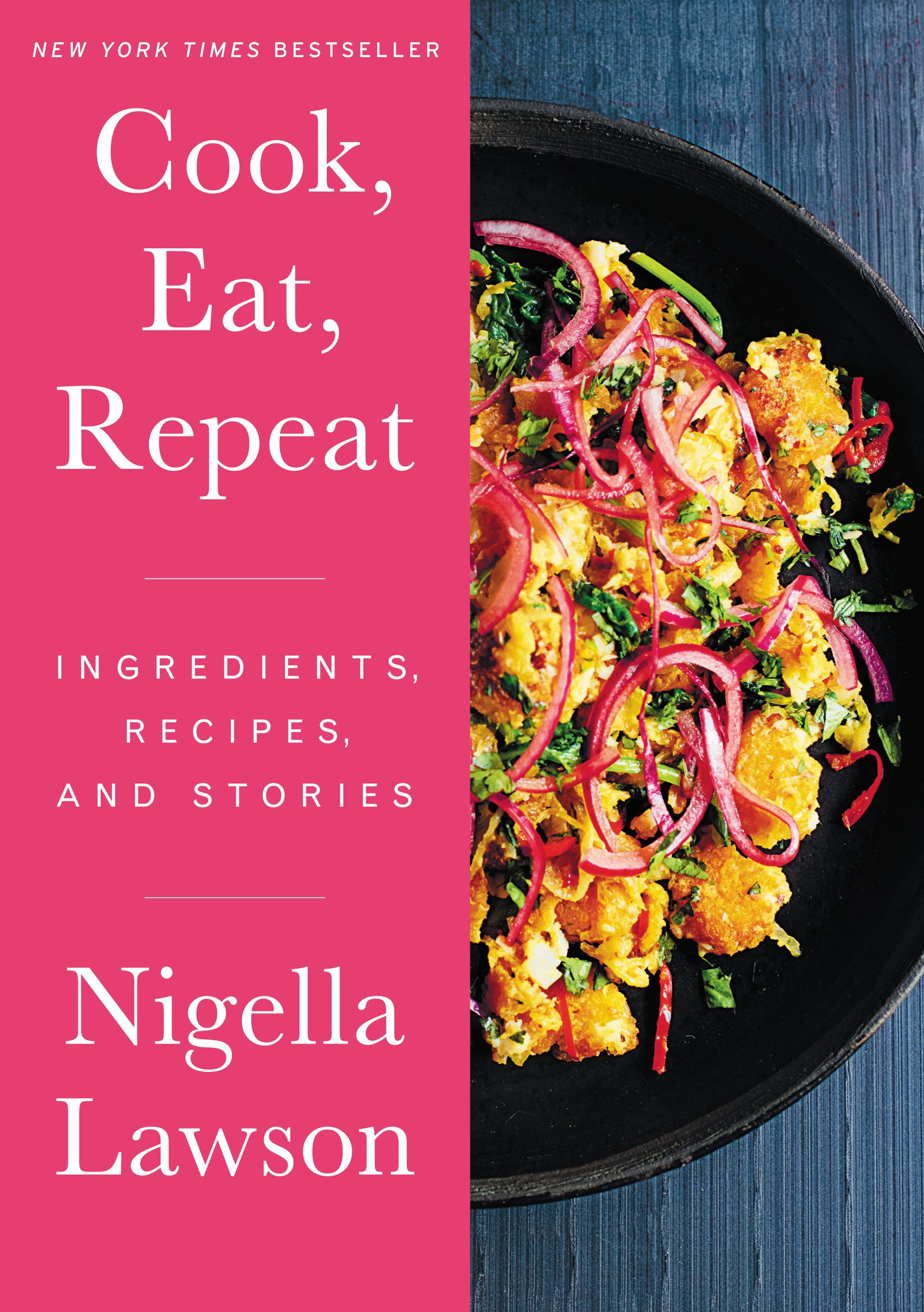In her first cookbook, British kitchen high priestess Nigella Lawson shared her emphatic beliefs on how to eat.
“How everyone really interacts with food is through the eating,” she says. “It’s a language that speaks to those who perhaps consider themselves cautious in the kitchen and don’t regard themselves as cooks.”
With repetition at the heart of comfort, Lawson’s latest collection of recipes, “Cook, Eat, Repeat: Ingredients, Recipes and Stories,” was born from the four-month long lockdown in the UK.
“Ritual and repetition have always been the markers of human society,” she says. She discusses a luscious stew recipe for beef cheeks with port and chestnuts that conjures up a Dickensian Christmas, a holiday feast living again in the form of sandwiches, and her love of an English hot mustard.
Good Food host Evan Kleiman will be joining Nigella Lawson in conversation on Saturday, Nov. 12 at the Granada Theater in Santa Barbara, and again at the Barclay Theater in Irvine on Nov. 26.
Beef Cheeks with Port and Chestnuts
Serves 3-4
This is a deeply flavored and elegantly cozy stew, perfect for when the nights are drawing in. It warms body and soul, and lifts the spirits; eating it feels like you’re instantly sitting in front of a crackling log fire. Show me a stew that isn’t comforting, but this one has something undeniably festive about it, too. It’s like wearing party shoes you can actually walk in.
The chances are you will have to get the beef cheeks from a butcher’s, and so you might as well get them to cut the meat up into chunks for you at the same time. After long, slow cooking beef cheeks become lusciously tender, but they certainly don’t start off that way: if you’re cutting them yourself, proceed with care. And if you can’t get beef cheeks, use beef shank.
I often make a horseradish sauce to eat with this, and if you want to do likewise, just stir together 3 tablespoons (packed) of finely grated fresh horseradish, 3 tablespoons of heavy cream, 1/4 cup of whole milk Greek yogurt (or replace the cream and yogurt with 7 tablespoons of creme fraiche or sour cream) and add a drop of vinegar and salt to taste. You can do this in advance, but just before serving add—if you so wish—a tablespoon or so of finely chopped chives. However, if you’re thinking of eating the beef cheeks with baked potatoes, then I’d boost the quantities of sauce.
Baked potatoes are certainly an easy accompaniment, and always a good one, but I have to say my absolute favorite partner for this is the Celery Root and Anchovy Gratin on p.23. And if that’s the plan, you don’t need the horseradish sauce. Either option is gratifying, but which I choose depends on how much time I have at my disposal.
While this is enough for four people, there are not likely to be leftovers, but I’m happy to cook this when there are three or even two of us. In which case, should you have leftovers, I can excitedly tell you to slightly shred the meat in its sauce and reheat gently on the stove, adding a little more water as needed, and maybe a small splosh of the port you used to cook it, and turn it into a pasta sauce. If you’ve only got a teeny bit left, do bump it up with some cream.
Warning: this needs to be made at least a day (and up to 3 days) before you plan to eat it.
Ingredients
- 2½ pounds beef cheeks
- 3–4 large leeks (6¼ cups sliced, white parts only)
- 2 fat cloves of garlic
- 2 carrots (approx. 2 cups, large chunks)
- 1 large or 2 small celery stalks
- A small bunch of Italian parsley (approx. 1 cup)
- 3 tablespoons beef tallow or 3 tablespoons oil of your choice
- 1 orange
- 1 teaspoon fennel seeds
- A very generous grating of nutmeg
- ¾ cup plus 2 tablespoons ruby port
- 1½ cups beef broth
- 2 teaspoons Worcestershire sauce (gluten-free if necessary)
- 1 teaspoon flaky sea salt or kosher salt (or ½ teaspoon fine sea salt)
- A good grinding of pepper
- 1 cup cooked and peeled chestnuts (I buy these in vacuum-sealed bags)
Instructions
- Heat the oven to 300°F. Tear off a generous piece of parchment paper a bit bigger than the diameter of your Dutch oven (I use a heavy-based one of 9 inches diameter) and set aside for now.
- Cut the beef cheeks into large chunks, about 2 ½ inches; if the cheeks are still covered in membrane, carefully cut it away and peel it off first. Trim then wash the leeks to remove any mud, as needed. If your leeks are chunky, cut them in half lengthways, and then into 1-inch slices; if they are relatively slender, just slice them. Peel the garlic cloves.
- Peel the carrots, cut into chunks, drop into the bowl of the processor, and add the peeled garlic. Tear the celery into smaller pieces and add, too, along with the parsley (leaves and tender stalks), and blitz until very finely chopped. Or just chop everything finely by hand.
- Melt 2 tablespoons of beef tallow or warm 2 tablespoons of oil in your Dutch oven and, in two batches, brown the meat over medium-high heat, then remove to a bowl.
- Add the remaining tablespoon of tallow (or tablespoon of oil) to the pan, turn the heat down to medium-low, then add the carrot mixture and cook, stirring, for 3–4 minutes.
- Finely grate the orange zest into the pan, and stir in the fennel seeds and grate in the nutmeg—which smell heavenly as they hit the heat—then add the leeks. Turn up the heat to medium and cook, stirring frequently, for about 5 minutes, by which time the leeks will have wilted a bit.
- Return the meat to the pan, scraping in any juices that have collected in the bowl, and stir well so that everything is mixed together.
- Pour in the port and let it bubble up before adding the beef broth, Worcestershire sauce and salt, and grind pepper generously into the stew. Add the chestnuts, stir well and, when bubbling, squish the meat down in the pan with your spoon or spatula so that it is just submerged in the liquid. Scrunch up your piece of parchment paper, unscrunch it and press it down on top of the stew, tucking the edges in and up around the inside of the pan, then put on the lid and cook in the oven for 3 hours, by which time the meat will be gorgeously tender. Remove lid and parchment and let cool before refrigerating for up to 3 days. Though you certainly should taste for seasoning before letting it cool too much.
- To reheat, take the stew out of the fridge, remove any of the now solidified fat on the top if you wish, and let come to room temperature.
- If the meat isn’t just covered by its gelled stock, add a little water so that it is. Tear off a sheet of parchment paper to make a fresh cartouche and replace the lid and, if serving with the Celery Root and Anchovy Gratin, put in a 375°F oven for 50 minutes to 1 hour, making sure the gratin is on the shelf above the Dutch oven. If you want to bake potatoes in the oven at the same time—although you’ll need to give them a head start—you can reheat at 400°F for 40–50 minutes. Make sure the stew is piping hot before you serve it.
From “Cook, Eat, Repeat: Ingredients, Recipes, and Stories” by Nigella Lawson. Copyright 2021 Nigella Lawson. Excerpt by permission of Ecco, an imprint of HarperCollins Publishers.

“I’m a great believer in cooking ahead, it makes me feel safer and secure when I know there is food to be eaten later,” says British cook and writer Nigella Lawson. Photo by Matt Holyoak.

Lawson’s latest collection of recipes, “Cook, Eat, Repeat,” was born from the four-month long lockdown in the UK. Photo courtesy of Ecco.
